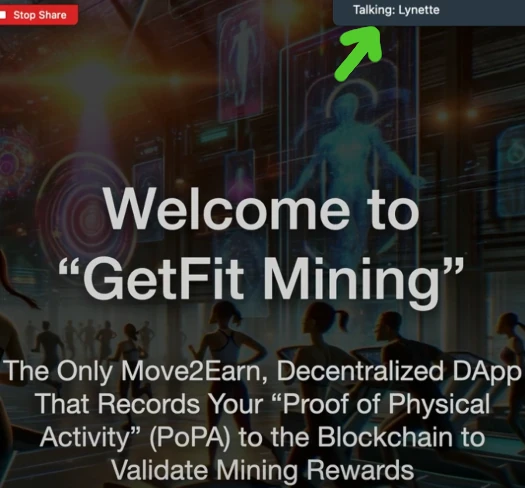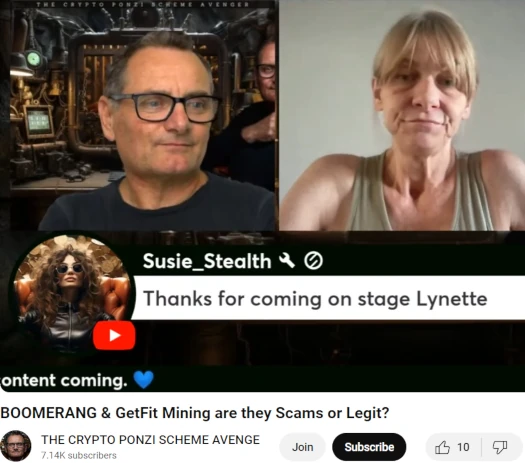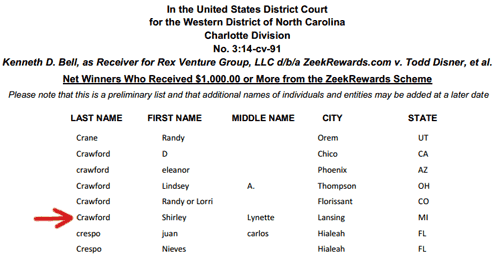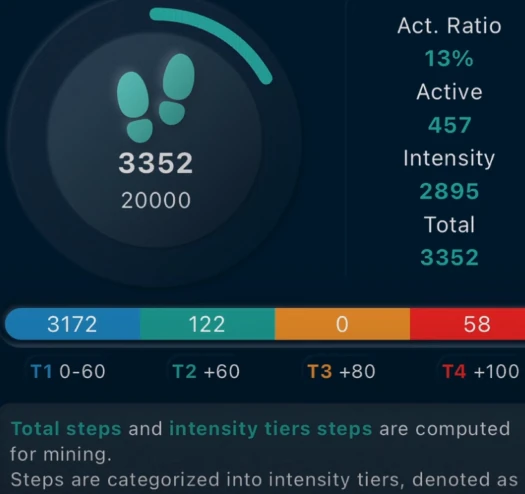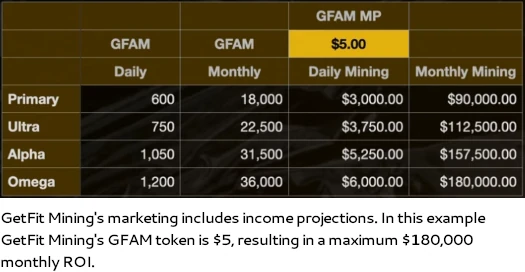
GetFit Mining’s website domain (“getfitmining.com”), was registered in March 2022. The private registration was last updated on March 26th, 2023.
A YouTube video embedded on GetFit Mining’s website leads to a YouTube channel titled “GetFit Activity Mining”. There we find GetFit Mining marketing videos hosted by “Lynette”.

On April 16th, Danny Dehek held a livestream covering GetFit Mining on his “The Crypto Ponzi Scheme Avenger” YouTube channel.
At around [1:29:11] DeHek reveals he was contacted by Crawford in her capacity as GetFit Mining’s owner. This tracks with Crawford featuring in GetFit Mining’s marketing videos.
DeHek calls Artin as part of his livestream. She doesn’t answer but did call him back at [2:03:22].
Crawford, a US resident who also goes by “Lynette Artin”, is known to BehindMLM as a net-winner in the Zeek Rewards Ponzi scheme.
How much Crawford stole through Zeek Rewards is unclear, but it was enough to see her targeted through clawback litigation.
After Zeek Rewards was shut down by US authorities in 2012, Crawford’s name popped up in association with numerous reload scams; GoFunRewards, OfferHubb, Uptown Offers, Quick Pay Group and CrowdFundFast.
As always, if an MLM company is not openly upfront about who is running or owns it, think long and hard about joining and/or handing over any money.
GetFit Mining’s Products
GetFit Mining has no retailable products or services.
Affiliates are only able to market GetFit Mining affiliate membership itself.
GetFit Mining’s Compensation Plan
GetFit Mining’s compensation plan combines a passive returns staking investment scheme with referral commissions.
Passive Returns (staking)
GetFit Mining affiliates invest GFAM tokens on the promise of a passive ROI of up to 25% per investment.
GetFit Mining affiliates can either purchase GFAM tokens through the company, or generate them through a convoluted task process.
Obtaining GFAM tokens through GetFit Mining requires purchase through an internal exchange. GetFit Mining sets the GFAM token value they sell at.
GetFit Mining’s convoluted task process sees affiliates generate GFAM through physical activity.
This begins with a GetFit Mining affiliate purchasing their token generation rate (note the amount spent also correlates to the staking ROI):
- Primary – pay $99 for a 100% token generation rate
- Ultra – pay $199 for a 125% token generation rate
- Alpha – pay $499 for 175% token generation rate
- Omega – pay $899 for 300% token generation rate
GFAM token generation rates are tracked through NFT positions. Note that affiliates can purchase multiple positions to increase the amount of GFAM tokens they can generate daily (and increase their passive staking ROI).
GetFit Mining caps physical activity at 20,000 steps or 10 miles (16,000 km) per 24 hours. Further restrictions include up to 2 hours of daily recorded activity.
There is also a tier system within GetFit Mining, which adds a multiplier to generated tokens:
- Tier 1 – 5% bonus
- Tier 2 – 10% bonus
- Tier 3 – 20% bonus
- Tier 4 – 30% bonus
Note these tiers aren’t defined within GetFit Mining’s marketing material.
The tiers however are named “intensity tiers steps”, suggesting they might correlate to intensity levels tracked during physical activity.
There are additional undisclosed token generation bonuses based on calories burned and tracked sleep time (up to 8 hours a day).
Regardless of whether purchased through GetFit Mining or obtained through the convoluted task based scheme, token generation rate fees must be paid to participate in GetFit Mining’s passive returns staking scheme.
This is because returns within the staking investment scheme are determined by how much in fees have been paid.
GetFit Mining pays staking returns out in tether (USDT). The total ROI per GFAM token investment made is calculated based on the total token generation rate a GetFit Mining has paid for.
This starts at 1.39% for a 100% token generation rate (one Primary NFT position), and increases by 1.39% per 100% token generation rate up to 1700%. 1700% to 1800% adds 1.37% to the daily ROI rate.
Maxxed out at 1800% (six Omega NFT positions @ $5394), GetFit Mining affiliates are able to invest GFAM tokens for a 25% ROI.
The return is paid out through what appears to be a daily variable rate over 90 days.
Once invested, GFAM tokens are unlocked if either
- if the total ROI rate is hit within 90 days (1.39% to 25%);or
- the total ROI rate is not hit at 90 days from the date of initial investment
Residual Commissions
GetFit Mining affiliates pays referral commissions via a unilevel compensation structure.
A unilevel compensation structure places an affiliate at the top of a unilevel team, with every personally recruited affiliate placed directly under them (level 1):
If any level 1 affiliates recruit new affiliates, they are placed on level 2 of the original affiliate’s unilevel team.
If any level 2 affiliates recruit new affiliates, they are placed on level 3 and so on and so forth down a theoretical infinite number of levels.
GetFit Mining caps payable unilevel team levels at ten.
Referral commissions are paid as a percentage of token generation adjustment fees paid across these ten levels as follows:
- level 1 (personally recruited affiliates) – 25%
- level 2 – 5%
- level 3 – 4%
- levels 4 and 5 – 3%
- levels 6 and 7 – 2%
- level 8 – 3%
- levels 9 and 10 – 5%
- level 11 – 8%
Joining GetFit Mining
GetFit Mining affiliate membership is free.
Full participation in the attached income opportunity requires payment of token generation fees:
- Primary – pay $99 for a 100% token generation rate
- Ultra – pay $199 for a 125% token generation rate
- Alpha – pay $499 for 175% token generation rate
- Omega – pay $899 for 300% token generation rate
Note that in order to maximize passive returns and GetFit Mining’s compensation plan, multiple fee payments are necessary.
GetFit Mining Conclusion
GetFit Mining is your classic task-based Ponzi scheme. Here the task is physical activity but GetFit Mining could just as easily have investors rub their bellies or count backwards from a thousand.
This is because the task assigned in task-based Ponzi schemes has nothing to do with revenue generation.
Don’t get me wrong, more physical activity is great but shouldn’t be construed as a blanket legitimacy for GetFit Mining as a whole.
That comes down to regulatory compliance which GetFit Mining wholly fails at.
For starters GetFit Mining fails to provide consumers with information that allows them to make an informed decision about joining the company. This includes ownership and compensation details on the company’s website.
Then we have the elephant in the room, GetFit Mining’s staking investment scheme.
Either by completing a task or directly purchasing them, GetFit Mining affiliates acquire GFAM tokens.
GFAM is a BSC-20 token. BSC-20 tokens can be created in a few minutes at little to no cost.
Once acquired, GFAM tokens are then invested with GetFit Mining on the promise of a passive return.
To establish whether US securities law comes into play we need to establish the existence of an investment contract.
This is done through application of the Howey Test.
An investment contract exists if there is an “investment of money in a common enterprise with a reasonable expectation of profits to be derived from the efforts of others.”
In GetFit Mining we have affiliates investing GFAM tokens (whether they were directly purchased or task-allocated is irrelevant).
This investment is done into GetFit Mining through their staking investment scheme (a “common enterprise”), on the promise of a passive return determined by how much a GetFit Mining affiliate has paid in fees (“a reasonable expectation of profits’).
GetFit Mining affiliates acquire GFAM tokens and pay ROI rate fees but returns are generated entirely passively (“from the efforts of others”).
GetFit Mining’s offering satisfies the Howey Test, meaning its GFAM token “staking” investment scheme constitutes an investment contract.
Under US law this requires GetFit Mining and Shirley Crawford to register with the SEC.
A search of the SEC’s public Edgar database reveals neither GetFit Mining or Crawford are registered with the SEC.
This constitutes securities fraud, which the SEC asserts goes hand-in-hand with Ponzi schemes.
From a consumer due-diligence perspective, there is no verifiable source of external revenue entering GetFit Mining.
The only acceptable and legally required form of verification would be audited financial reports filed with the SEC.
It should be noted that securities law globally is, for all intents and purposes, similar to that of the US. In a country where financial markets are regulated, registration of securities offering with financial regulators in mandatory.
For reference, as of March 2024 SimilarWeb tracked top sources of traffic to GetFit Mining’s website as the US (79%), Canada (8%), Mexico (8%) and Norway (5%).
Despite committing securities fraud and having no verifiable source of external revenue to fund USDT ROI withdrawals, on her call with Danny Dehek Crawford asserted GetFit Mining is “not a Ponzi scheme and not a scam, five thousand percent” [2:10:16].
Having been sued for clawback as part of Zeek Reward’s securities fraud proceedings, not surprisingly GetFit Mining tries to brush off concerns on its website.
The GetFit tokens are not intended to constitute, and shall not constitute, securities in any jurisdiction.
- What GetFit tokens are intended or not intended to constitute is irrelevant to what they are; and
- the issue isn’t the tokens themselves being a securities offering, GetFit Mining’s “staking” investment scheme is a securities offering.
I’ll finish up by noting GetFit Mining is pretty similar to SmartSteps, another fitness task-based Ponzi BehindMLM reviewed earlier this year.
At time of publication SmartSteps’ website is no longer accessible. What it was live though, SmartSteps ran the same NFT investment position staking scheme through its BOLTYX BSC-20 tokens.
Taking a step back, task-based Ponzi schemes are nothing new. In Zeek Rewards, which launched in 2011, investors had to dump penny auction bids to qualify for returns.
Due to the nature of compounding, the amount of bids top investors had to dump daily quickly became unmanageable. This resulted in the creation of thousands of dummy accounts to dump bids on to.
Not that it mattered, dumping bids had nothing to do with revenue generation. Like all task-based Ponzi schemes, the assigned task was just busy-body work.
Again putting aside health benefits, with respect to revenue generation the same is true of GetFit and its daily fitness tasks.
The primary verifiable source of revenue is pretty obviously GetFit Mining’s token generation NFT position fees – which is why they correlate to how much of a return is paid out via the staking scheme.
As with all MLM Ponzi schemes, once affiliate recruitment dries up so too will new investment. GetFit Mining affiliates selling GFAM tokens internally without participating in the staking investment scheme will also dry withdrawable USDT up.
Either way this will starve GetFit Mining of ROI revenue, leaving it unable to pay USDT ROI withdrawals.
Given the variable nature of the return rate, this will likely present itself in said return dropping to near-zero before collapsing altogether.
Math guarantees that when a Ponzi scheme collapses, the majority of participants lose money.
In GetFit Mining, this will result in affiliates bagholding GFAM, which outside of GetFit Mining’s staking investment scheme, is otherwise worthless.
